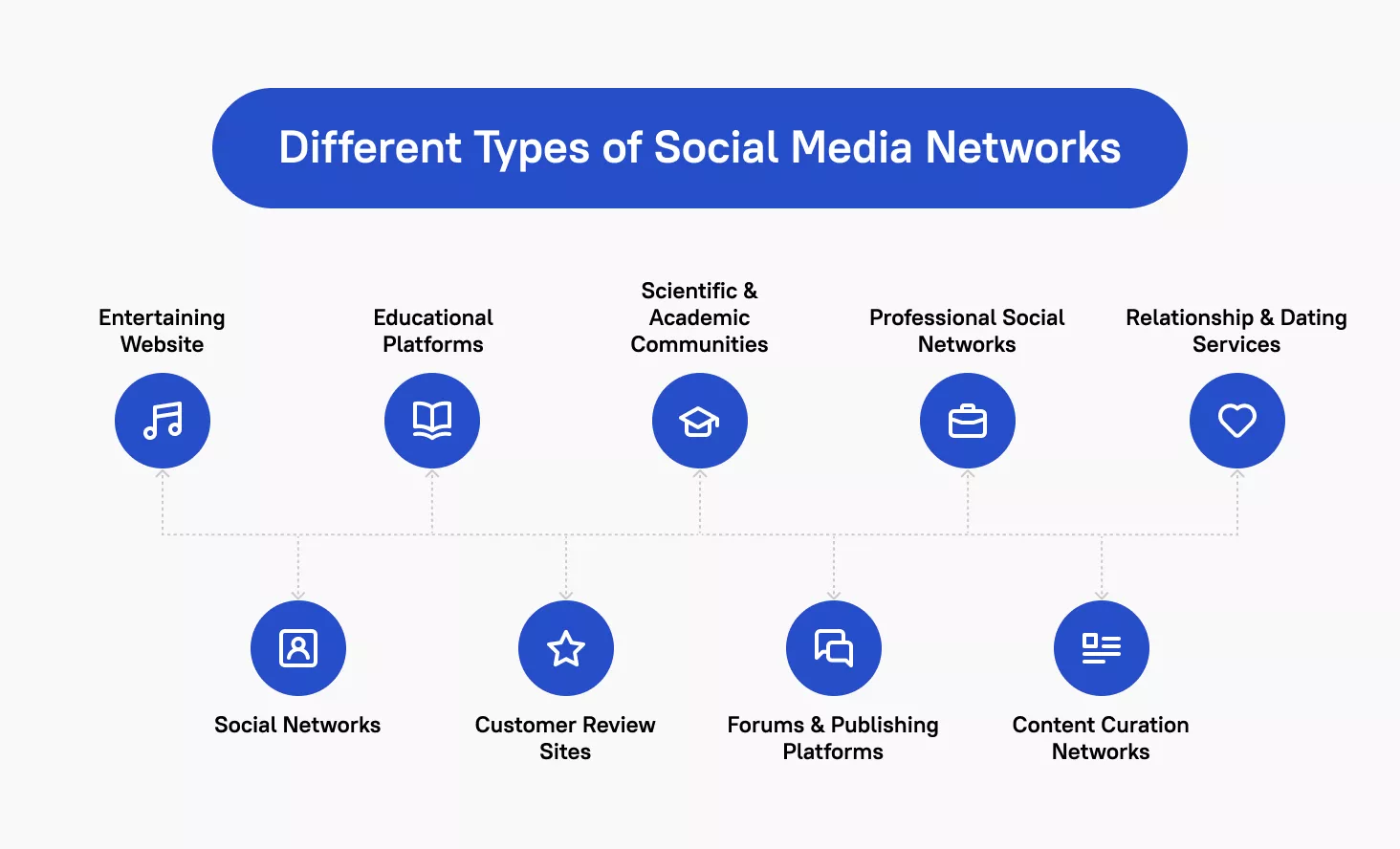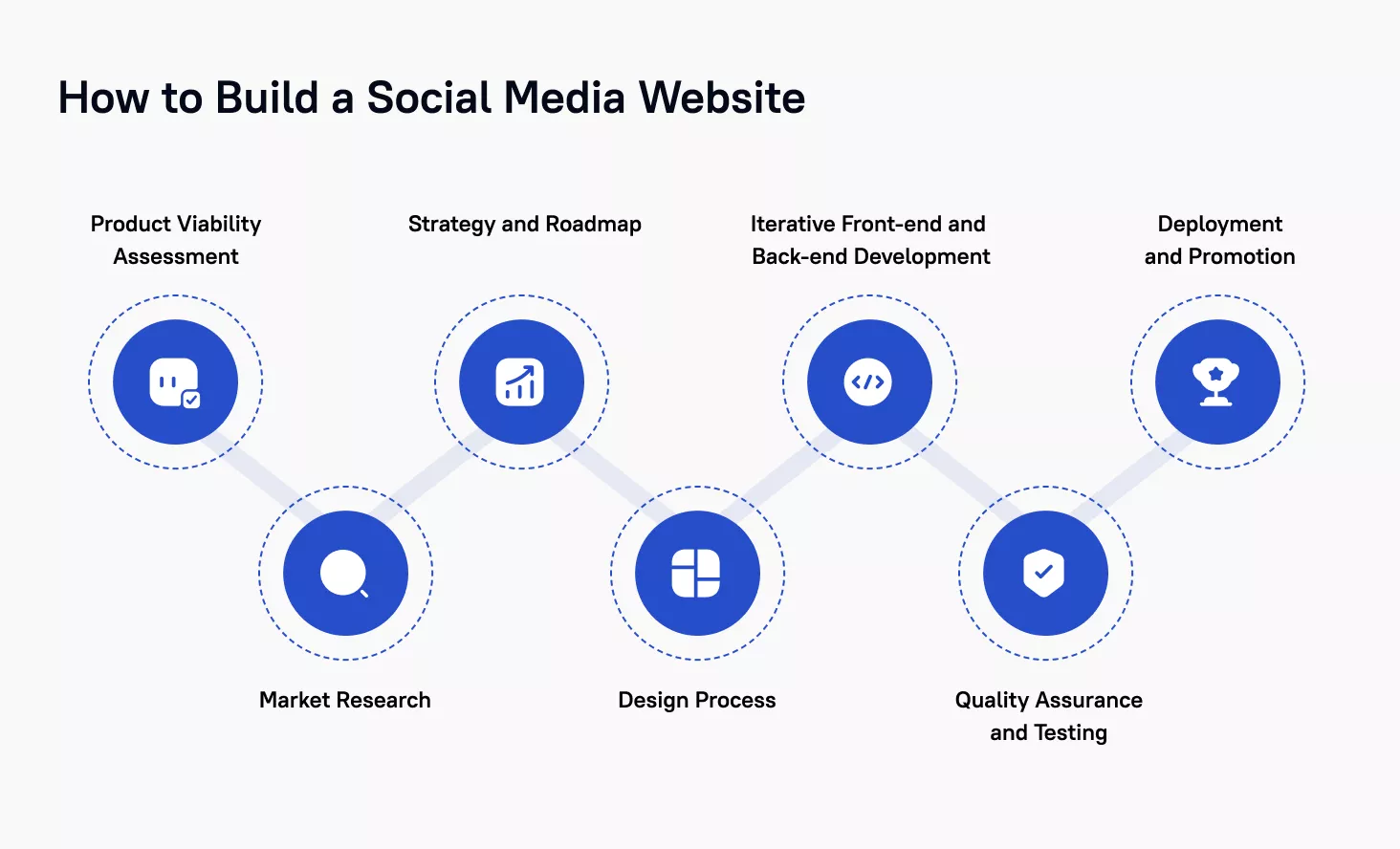
Can you replicate the phenomenal success of Facebook and build your social networking site? Nothing is impossible, as this top-notch platform used to be a simple experimental website accessible only to Harvard students. It is inspiring, don't you think?
Keep reading this article, and we will explore the phenomenon of online networking and answer your question about how to make a social media website from scratch.
Social Network Market Overview
In 2004, the launch of MySpace signaled a turning point for the development of social media websites. In October 2023, the global internet user count reached 5.3 billion, constituting 65.7 percent of the world's population. Out of this, 4.95 billion individuals, equivalent to 61.4 percent of the global population, were active social media users, according to Statista.
In 2022, the average daily use of different types of social media by Internet users worldwide was 147 minutes per day, which means that the relevance of this segment is higher than ever. The statistics are impressive, aren't they? To know which niche to choose if you start a new social network, let's look at the types of existing digital networks.

What is a Social Media Website?
Social media is a collective name for websites and applications aimed at communication, community-based input, interaction, content sharing, and collaboration.
Business-to-consumer websites contain social components, such as comment fields for users. Several tools help businesses monitor, measure, and analyze the attention the company receives from social media.
Some famous examples of available social media platforms are Twitter, Facebook, and LinkedIn.
Want a web app that does more?
Let's build a solution that's smart, sleek, and powerful.
Alina
Client Manager

Most Successful Social Media Platforms
Numerous services compete for the attention of the more than 5 billion mobile device users in today's social media landscape. The top social media platforms are summarized below.
Facebook is the most popular social media platform, with over two billion monthly users. Facebook is a safe bet if you want to have a presence on social media because more than 200 million businesses use its tools, and more than 7 million advertisers actively promote their businesses there.
YouTube
Each day, users of the video-sharing website YouTube watch one billion hours of content. In addition to being the second-largest social media platform, YouTube is frequently referred to as the second-largest internet searcher after its parent company, Google. Therefore, if you promote your business through video marketing, YouTube is a must.
Instagram is the best place to showcase your goods or services through pictures or videos because it's a visual platform, another example of social networking. You can share a variety of media on the app, including images, Stories, reels, videos, live videos, and videos on IGTV.
TikTok
Even though Tik-Tok was launched in 2017, it is one of the fastest growing social media platforms worldwide and recently surpassed Google as the most popular website. TikTok is a fantastic social network for business if your target market is young. The US TikTok user base is about 47.4% of US residents aged 10 to 29
How to Earn on a Social Media Website
The segment of online social channels you want to enter and the monetization strategy you select are strongly correlated. Let's examine the three best ways to generate income from creating social media websites immediately.
You can give your users self-serve advertising that allows them to place their ads on the "sidebar" of the page, or you can enable brands to use specific tools, similar to Facebook's Dynamic Ads.
This type of monetization works best for publishing platforms (like Medium) or websites that host media (like Youtube). This approach will work perfectly for your social media network if you want to charge a fee for access to certain premium content or paid features.
It is one of the quickest ways to increase ROI in the short term. The main goal of this type of monetization is to encourage users to click on the affiliate link and buy the product or brand you select on your social media website.
Things to Consider Before Launching Social Network
By abiding by a few unwritten rules and guidelines, creating a new social media network can now be done quickly. Here are the key things you should consider before building a website.
1. Identify your audience
Identifying your target audience is necessary. Understanding the preferences and dislikes of your community will help you better understand the psychological factors that influence them as consumers and what you can do to capture their attention.
2. Define the platform features
It would help if you decided what features and capabilities a social networking site will have before you start building it. Various social networks may have varying features, making this point crucial.
3. Choose the right technology
The platform and business where you can build your network will depend on the features and functions of your social media network. Technology evaluation is a task that should be left to experts. The best solution is to hire a consultant to assist you in comparing technologies. You'll save both time and money.
4. Structure
Since you're attempting to engage users in social activity and keep them on your site longer, a few general guidelines that apply to building all web pages are extremely important for your social media networking platform. If you want your social media network to be successful and profitable, you must include these three essential pillars.
- Customer service
- Security
- Scalability
5. Activity Stream
A list of a person's most recent online activities, usually on a single website, is called an activity stream. An excellent example of an activity stream is Facebook's News Feed. The appeal of your social media network may only improve if you create a high-quality activity stream.
6. Status Update
A status update is essential. Every social media user desires free expression of their emotions and ideas at any time. It would help if you created the ideal tools to make creating status updates fun and simple. Although Facebook made the activity stream famous, Twitter helped make status updates a common feature of social media sites.
7. Options for viewing the data
You must develop numerous data viewing features that will increase the visibility of the content on your social media platform if you want to raise engagement levels and clickthrough rates on the website.
- Popular Upcoming Stories
- The most popular stories of the previous day
- Top Stories from the previous seven days
- Top Stories from the past 30 days
- Best Stories from the previous year
Users must come first when designing the data viewing features. It must be simple to use and accessible.
How to Make a Social Media Website from Scratch
When the target market has been identified, a social media niche has been selected, and a catchy name for the web app has been developed, it is time to move on to the actual design and development of the software solution. Learn the steps involved in creating a social network similar to Facebook.

1. Product Viability Assessment
To successfully build a social media platform from scratch, you must determine whether your idea is viable once you have developed a clear concept. It might be a great idea to seek out the assistance of a business analytics firm or a full-cycle development firm like Stfalcon with a proven plan and expertise in idea assessment and risk elimination.
2. Market Research
Any social media website's focus is on the user. Therefore, thorough market and competitive research are necessary to make sound tactical and strategic decisions that best satisfy your customers' needs and cut additional costs on your software development.
3. Strategy and Roadmap
Your product strategy is built on the data gathered during earlier phases. Please take into account the following elements to finish it.
- Create a complete set of enticing features in the product's overall concept;
- Create an image of how the website might develop in terms of its audience and revenue.
- If you want to develop mobile apps for iOS and Android in addition, or if you want to target more geographic areas and market segments, it's advisable to plan your expansion on other platforms in advance, such as Google Play or Apple Store.
4. Design Process
By producing wireframes and prototypes, choosing a thorough approach to designing a social media website is preferable. The wireframe, which focuses on the layout's fundamental principles, space allocation, and important interface components, can be either low-fidelity or high-fidelity static overviews of your product's interface. You can interact with the prototype, which shows you every aspect of the website's functionality.
5. Iterative front-end and back-end development
The next stage of the process is developing the social media website. Depending on the platform you selected in the previous step, there are different approaches you can take. Building a social network with standard features will take about a month. Most of the time is typically spent on design and code optimization using open-source solutions.
Technology Stacks Used for Social Media Website Development
The project complexity and the technical proficiency of software developers all play a role in deciding the right tech stack to program a social network.
SQL databases — PostgreSQL, MySQL, MariaDB, Oracle, MS SQL
NoSQL databases— MongoDB, DynamoDB, Cassandra,
Programming languages — PHP, Java, Python
Search engines — Elasticsearch, Apache Solr
Frameworks/libraries — Symfony, Laravel for PHP; Spring stack for Java; Django, Tornado, Flask for Python
Caching — Memcached, Redis
Front-end frameworks and technologies — Vue.js, Angular, React.js,
Front-end programming languages — JavaScript, TypeScript
DevOps — TeamCity, GitLab CI, WS CodeBuild, GoCD Jenkins, Terraform
What to Consider When Building a Social Network?
Making a social media platform operate seamlessly and reducing user churn are priorities when creating one from scratch. So, when developing the back end it's crucial to keep the following things in mind.
Proper rendering
This renders website content more statically and conventionally, which may cause a page load delay of up to a few seconds. Such a choice is ideal for bloggers and social media publishers because it doesn't require a prompt response after each page load.
This data display style is more appropriate if you want to create a website similar to Facebook. A network that will give you quick website rendering after the initial first load can be built using this method, which is more dynamic and responsive.
Increasing safety
If your security is inadequate, sensitive information from your users, such as credit card numbers and authentication information, may be susceptible to SQL injections. Ensure you install a secure Java database driver with a prepared statement feature to prevent such malicious attacks.
Developers must use escape input data or another technology to protect PHP database drivers because they lack these protections.
Your social media network's website is vulnerable to XSS attacks if the input data validation isn't adequately secured. If this is the case, consider incorporating input data filtration when it arrives or encoding your data on the output.
- Secure Hosting
- Data encryption
- Software updates
Administrative panel
This is one of the essential tools for social media website moderation that you should notice. It is a comprehensive application that communicates with your website and aims to improve your company's capabilities by:
- offering insight into the user-related functions (user behavior);
- identifying a violation of the rules and policies of the website;
- showing business metrics (KPIs).
Improving performance
The more concurrent workloads are running on the website, the more well-known your network becomes. Maintaining horizontal scalability is essential to build a social media platform like Facebook.
You can boost the performance of your website by using a CDN (content delivery network). By utilizing the closest or local edge servers, such a solution offers faster content delivery to your end-users who are situated far from the hosted server.
Continuous Integration and Continuous Deployments
Continuous integration and continuous deployments are essential in developing social media websites to create an effective and adaptable workflow. DevOps engineers are responsible for setting up and maintaining an effective CI/CD setup for the development lifecycle.
Quality Assurance and Testing
It is ensured through testing that the software vendor has a complete understanding of all client requirements. Additionally, they make it possible for the customer, stakeholders, and testers to follow changes made to the project, preventing potential misunderstandings between the parties.
Deployment and Promotion
Before the website's official launch, a social network is programmed and tested iteratively. Then, the developer freezes the code for the next two to three weeks and keeps fixing bugs without changing the product.
- verify the functionality of each URL.
- Determine if your website is user- and mobile-friendly.
- Make sure your HTML/CSS code is error-free;
- Double-check your website's security component, and ensure your social network has a backup.
Once your social network has approved the release, it's time to implement your marketing plan.
What is the Cost of Developing a Social Network?
When creating your social networking website, it's essential to develop an MVP first to pinpoint the product's shortcomings and the precise improvements needed before investing more.
Building a social network from scratch requires such a rough stack of software developers. The price to develop your social network website varies between software providers from various countries, as shown in the table below.
USA
The average hourly rate is $80;
MVP cost: $70,000 — $85,200;
Total product cost: $123,000 — $144,000.
Western Europe (Germany)
The average hourly rate is $65;
MVP cost: $57,000 — $70,000;
Total product cost: $123,000 — $144,000.
Eastern Europe (Ukraine)
The average hourly rate is $40;
MVP cost: $35,000 — $43,000;
Total product cost: $62,000 — $72,000.
How Can Stfalcon Help You to Make a Social Network?
Stfalcon is an award-winning software development company from Ukraine with 13+ years of experience building web and mobile solutions for any business size worldwide. To help you launch your social media website, Stfalcon offers several benefits:
- Knowledge in various fields, including media, education, retail, e-commerce, etc.
- All necessary specialists are on hand, including designers, PMs, QA engineers, analysts, and mobile and web developers.
- Guaranteed product quality and full-cycle software development.
- A flexible pricing structure for social media websites includes a fixed price, a dedicated team, time, and materials.
Numerous software development projects in various industries are represented in our portfolio.
Bottom Line
Above you have read how to make a social media website from scratch. The stakeholders' creativity only constrains social media's potential. The current social media landscape will change due to rapid technological changes, escalating financial demands, and shifting cultural dynamics.
There needs to be more than just making a social media website because the social network niche is popular and fiercely competitive. To keep your website current and relevant, working with an experienced vendor is essential. If you are interested in creating a social app, just contact us, free consultation is available.



